High-temperature sealant for furnaces: features of application + five of the best offers
The absence of cracks, cracks in the system of the heating unit is one of the mandatory requirements for its safe use. For these purposes, a high-temperature sealant for furnaces is used, which is able to maintain insulating qualities in extreme operating conditions.
We will figure out how to choose the right composition, what to look for when buying and what rules should be followed when applying sealed paste. To simplify the task of selection, we indicate the five best offers from different manufacturers.
The content of the article:
Purpose of furnace sealants
During the active use of fireplaces and stoves, brickwork may crack. The risk of cracks increases if the brickwork is not tiled, not protected by a plaster layer and not covered heat resistant paint.
Repair work cannot be put off - using such a fireplace or stove becomes unsafe.
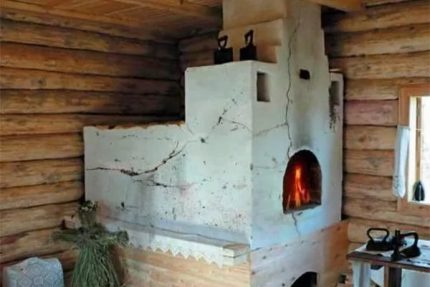
Possible problems due to through cracks:
- fuel consumption increases due to the fact that additional air leaks into the combustion chamber;
- soot comes out of the cracks - a corresponding coating appears on the ceiling, walls; in such situations even chimney cleaning does not solve the problem;
- combustion products hazardous to health enter the room - there is a risk of poisoning;
- periodic attenuation of the igniter flame - probably during depressurization of the chimney;
- the fuel burns at low temperatures, which is why more soot settles on the walls of the chimney pipes.
Depressurization of the heating system and the abundance of soot is a fire hazard combination. Incoming oxygen provokes ignition inside the chimney.
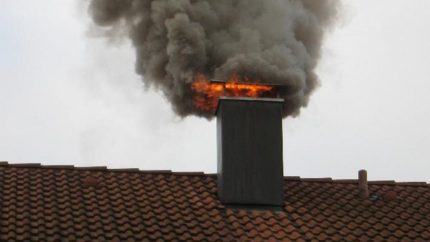
Avoid serious problems will help timely sealing cracks and gaps. It is clear that only heat-resistant compounds are suitable for such extreme operating conditions.
Classification of High Temperature Compositions
The characteristics of the sealants depend on the basis of the thermal insulating paste. For processing fireplaces and stoves, compounds based on silicate and silicone are suitable. The first group is heat-resistant sealants that can withstand direct contact with the flame, the second group is heat-resistant pastes. Their operating temperature is much lower than refractory compositions.
Each type of sealant has its own characteristics and priority area of use.
Silicate - heat resistant mixtures
Sealing paste based on sodium silicate. Externally, the material looks like a viscous mixture of black. After solidification, an inelastic layer forms on the surface.
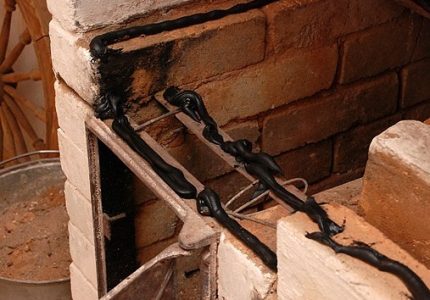
If this requirement is neglected, there is a risk of cracking of the insulation joint.
Technical characteristics of silicate compositions:
- permissible temperature indicators: short-term - 1400-1500 ° С, long-term - up to 1300 ° С;
- solidification time - 15 minutes;
- maximum seam thickness - 15 mm;
- release form - plastic tubes;
- linear deformation without destruction of the hardened mass - 7%;
- application conditions - temperature in the range of 1-40 ° C, the exact value depends on the manufacturer.
Silicate compositions have good adhesive properties. To increase the reliability of the coupling, it is desirable to pre-treat the metal, concrete or brick base with an abrasive.
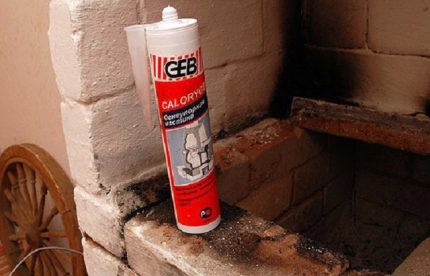
Heat-resistant paste is most effective in sealing joints of fixed elements with a similar coefficient of expansion.
When it is advisable to use silicate sealant:
- sealing slots of combustion chambers and other surfaces in contact with fire, as well as high-temperature gases;
- closing cracks formed between steel, cast-iron elements of stove appliances and brickwork;
- sealing chimneysthat remove high-temperature gases, for example: solid fuel boilers and bath stoves;
- processing areas of the casting installation;
- elimination of leaks in heating boilers.
Heat resistant pastes are used for assembling a sandwich chimney - sealant process the docking surface.
Silicone - Heat Resistant Seals
The silicone-based insulation paste has a brownish-reddish color. The hue is due to the addition of iron oxide to the product. On sale are heat-resistant silicone sealants with different operating temperatures, the range of values is 170-300 ° C.
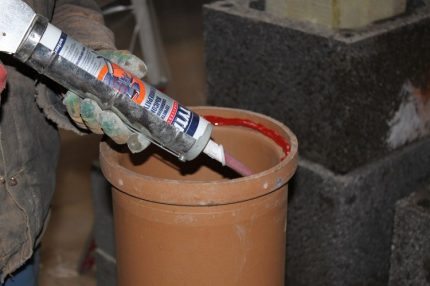
Silicone sealants retain elasticity after drying - deformation loads, shrinkage of furnaces are not afraid of seams. An additional plus is excellent water resistance, which allows the composition to be used to seal cracks in the areas of contact between the roof and the chimney. Silicone paste cannot be painted.
Technical characteristics of heat-resistant sealants:
- operating temperature range - within + 300 ° С;
- packaging - tubes, packing of 310 ml;
- drying period - about 20 minutes;
- drawing on a cold base at plus air temperature, but not more than + 40 ° С;
- resistance to UV rays;
- sealing cracks with a depth of 6 mm.
The cost of silicone thermo sealant is often lower than silicate fellow. However, due to the insufficient temperature threshold, its use is limited to the processing of not too hot surfaces.
Scope of use:
- sealing brick chimneys in street areas;
- sealing joints of the exhaust duct and roofing material;
- processing of flue gas ducts made of metal, brick and sandwich panels, provided that boilers with an efficiency of more than 90% are used - the temperature of the outgoing gases does not exceed + 150 ° С;
- processing of non-through cracks on the brick external surfaces of stoves and fireplaces.
The high temperature composition is also suitable for sealing threaded joints when installing heating circuits.
Types of thermo-sealants by release form
Most manufacturers sell insulation compositions for tube furnaces. Before use, a cylindrical container is installed in a construction gun.
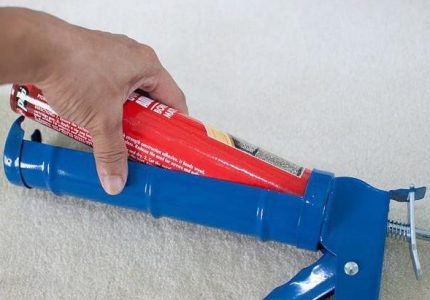
There are products in soft small tubes. It is advisable to use them for processing small areas. Any additional devices for applying the composition are not needed.
High-temperature sealants are produced in the form of one- or two-component compositions. The first category is most actively used in everyday life.
One-component composition is ready to use, does not require any preparation. This sealant dries longer, leaving time in reserve to correct possible errors.
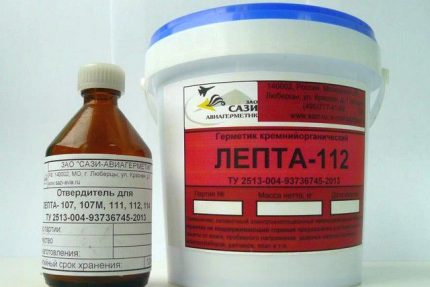
This option is often used in industrial conditions, when it is necessary to process significant areas. In everyday life, two-component mixtures did not take root due to the technological complexity of the application.
A suitable tool selection algorithm
Knowing the properties, the recommended scope of application of different composition of high-temperature sealants, it will be easy to make the right choice.
So, attention should be paid to the following parameters:
- operating temperature;
- environmental friendliness;
- brand name.
Temperature endurance. The indicator depends on the basis of the sealant - silicone or silicate. When choosing, it is necessary to compare the forthcoming operating conditions of the paste with the values of the maximum allowable temperature.
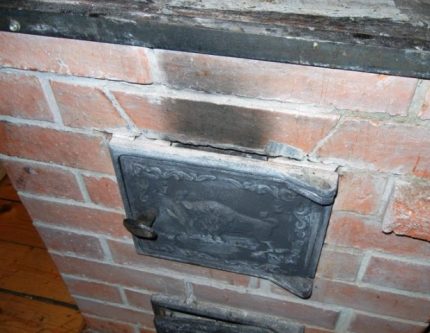
If you save money and buy a cheaper analogue, then the components will simply burn out over time - the mineral filler will delaminate and you will have to repair the heater again.
Environmental friendliness. The composition should not contain substances emitting toxic volatile compounds during heating. Regular inhalation of such vapors adversely affects people's health.
To protect yourself, it is better to refrain from buying goods from unknown manufacturers at a suspiciously low price. It is necessary to carefully examine the packaging - spelling mistakes are often made in fakes, and the text itself can be printed illegibly.
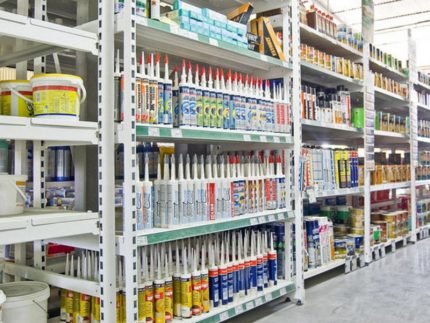
Company manufacturer. Among a wide range of customers, domestic and foreign firms won the trust of buyers: "Moment", Masterteks, Penosil, Kraftool, Alteco, Tytan, Soudal, Makroflex and etc.
Rules for the use of thermal sealants
The tactics of using silicone and silicate mixtures are similar to each other.However, there are also features that must be remembered when sealing furnace equipment.
Work with silicone compound
In addition to the construction tool for work, it is necessary to prepare: a rubber spatula, latex gloves, a brush.
The processed surface needs preparation:
- clean and degrease the base;
- it is desirable to process metal elements with sandpaper to improve adhesion;
- wait until the surface has completely dried if water was used during cleaning.
The next step is to refill the cylinder with a construction gun. Cut off the sealed cap at an angle.
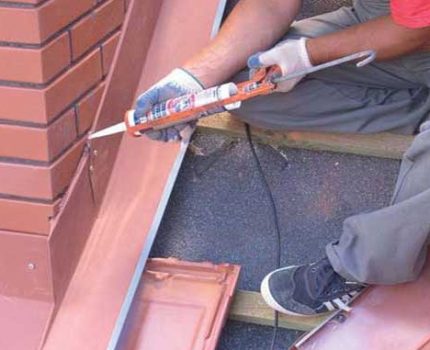
For uniform hardening, the silicone composition must provide air access. Therefore, the sealant thickness recommended by the manufacturer cannot be exceeded.
Full cure time depends on conditions. The hardening speed is indicated on the packaging at the optimum performance: humidity - 50%, temperature - 23 ° C. In practice, the values vary widely. The lower the room temperature, the longer the sealant will “set”.
Technology for applying heat-resistant sealant
For processing with a refractory composition, in addition to the tools and materials described above, you will need a masking tape and a construction knife.
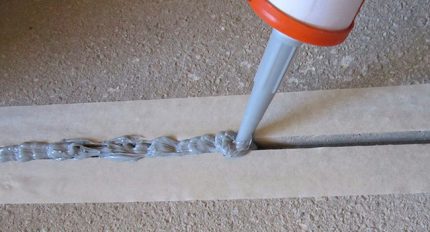
Surfaces are prepared in the same way as before applying the silicone composition: they are cleaned, degreased, the metal is “sanded" with an abrasive.
Technological nuances of using silicate sealant:
- the porous base must be dusted off and slightly moistened;
- work is carried out only at positive temperature, optimally - over + 20 ° C;
- when applying the mixture adhere to the insulation thickness recommended by the manufacturer;
- excess sealant must be removed immediately, without waiting for the mixture to dry;
- the masking tape is removed after applying the composition.
Some furnace sealants need drying for many hours at different temperatures. This information must be clarified in the product instructions.
Top 5 Best Deals
Demand for high-temperature silicone and silicate sealants is very high, therefore such products are present in product lines of many manufacturers. In order not to get confused in the variety of offers, we give a list of the most worthy and popular compositions from foreign and domestic companies.
1st place - Penosil + 1500 ° C Sealant
The first place was given to the silicate compound from the Estonian manufacturer Penosil. Despite the claimed high technical characteristics, the sealant is relatively inexpensive.

Penosil is suitable for outdoor, indoor use, for example contact with stone, brick, concrete, metal.
Specifications:
- temperature resistance - 1500 ° C;
- mobility - 0%;
- color is dark gray;
- application temperature - 5-40 ° C;
- solidification time - about 24 hours;
- volume - 310 ml.
Among the main advantages of refractory sealant note: low cost, excellent quality, ease of use, versatility. User reviews are mostly positive, Penosil copes with the task. Minus - the duration of solidification, the oven can be turned on a day after processing.
2nd place - Makroflex TA145
The Belgian company specializes in the production of insulation and sealants. The range includes heat-resistant silicone mixture. Scope of application - places exposed to temperatures not exceeding + 260 ° C.
The composition is undesirable to use for the processing of metal elements prone to corrosion (lead, copper). During the hardening process, the sealant releases vapors of acetic acid.
Specifications:
- stable heat resistance - 60-260 ° C, short-term exposure is permissible - up to 315 ° C;
- width of the applied layer - 6-30 mm, depth - from 2 mm;
- solidification time - about 2 days;
- application conditions - temperature within 5-40 ° С.
It is necessary to provide good ventilation during polymerization in the room - inhalation of acid vapor can lead to poisoning. After drying, the sealant is safe.
3rd place - Soudal
Sodium silicate sealant paste. The composition does not contain asbestos, therefore, after hardening, the insulating layer does not crack and does not crumble. Temperature resistant Soudal - 1500 ° C.

Suitable for concrete, metal, brick bases.
Specifications:
- mastic color - black;
- maximum heat resistance - 1500 ° C;
- working temperatures - 1-30 ° С;
- deformation during movements - not more than 7%;
- film formation time - 15 minutes at + 20 ° С and humidity 65%;
- cartridge volume - 300 ml.
Despite the higher cost than the silicate analog from Penosil, Soudal sealant is in demand. The composition is suitable for filling cracks whose depth does not exceed 5 mm. If the gap is larger, you can block the main part with another material, and treat the top with heat-resistant sealant.
4th place - Kraftool Kraftflex FR150
Silicate based heat resistant compound. The sealant is inert to chemical influences and perfectly resists atmospheric factors.
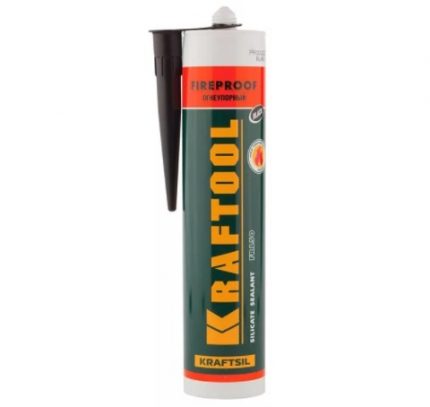
Special restrictions on use Kraftflex FR150 no. It is suitable for sealing elements exposed to direct flame exposure, for fixing refractory bricks and air pipes.
Specifications:
- the color of the paste is black;
- the maximum allowable heating temperature is 1500 ° C;
- film formation time - 15 minutes;
- hardening speed - 2 mm / 24 hours;
- operating temperature - 5-40 ° C;
- packing - 300 ml each.
Sealant is indispensable for objects operating in extreme conditions. The composition can withstand temperature drops to -40 ° C. Cons Kraftflex FR150: drying time, relatively high price.
5th place - Moment Herment
Water-resistant high-temperature sealant based on silicone. The mixture is inert to chemicals, maintains insulating qualities in conditions up to + 216 ° C.
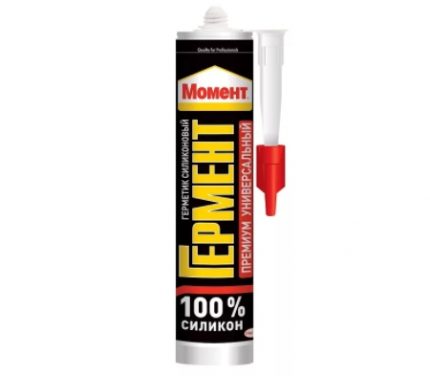
It is undesirable to use on mirror and stone surfaces.
On practice Herment showed reliable adhesion with various materials. Silicone insulator gasoline and oil resistant, not afraid of UV radiation.
Specifications:
- maintains stability at -65 ° С ... + 260 ° С; short-term temperature jumps up to + 315 ° С are permissible;
- film formation time - 10 minutes;
- polymerization rate - 1.5 mm / day;
- color - brick red;
- elongation at break - 115%;
- the volume of the bottle is 300 ml.
The fifth place in the rating is due to the high cost of the product. In practice, Germent proved to be good - it is easy to apply, dries quickly enough, and forms a reliable bond with materials.
Conclusions and useful video on the topic
Overview of furnace sealants, recommendations for choosing the optimal composition:
The rules for applying a sealing compound on the example of heat-resistant Penosil paste:
The quality of the repair and subsequent operation of the furnace depends on a number of factors. An important role will be played: the correct choice of the composition of the sealant, adherence to the technology of its application and drying. It is necessary to compare the characteristics of the insulating paste with the conditions of its use and study the manufacturer's instructions before performing repair work.
Looking for a quality high temperature sealant for ovens? Or is there experience using an insulating compound to seal cracks or crevices in a heating unit? Please leave comments on the article, ask questions and participate in discussions. The contact form is located below.

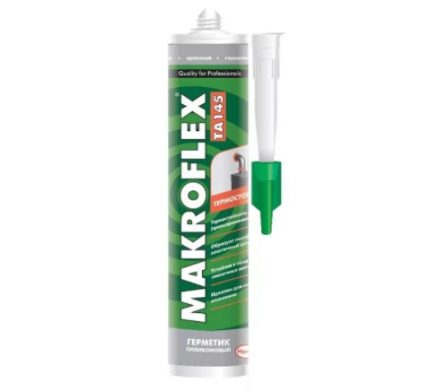
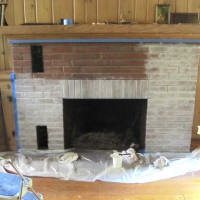 Heat-resistant paints for stoves and fireplaces: an overview of popular heat-resistant compounds
Heat-resistant paints for stoves and fireplaces: an overview of popular heat-resistant compounds 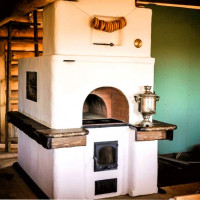 How the Russian stove works: design features and an overview of popular types of Russian stoves
How the Russian stove works: design features and an overview of popular types of Russian stoves 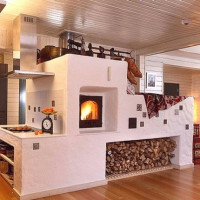 Types of brick ovens for the home: types of units according to purpose and design features
Types of brick ovens for the home: types of units according to purpose and design features  Cleaning chimneys of stoves and fireplaces from soot: the best means and methods of getting rid of soot in a pipe
Cleaning chimneys of stoves and fireplaces from soot: the best means and methods of getting rid of soot in a pipe 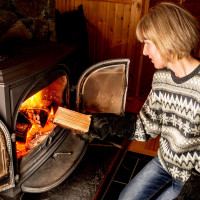 Chimney sweep log for chimney cleaning: composition of the product and rules of use + owner reviews
Chimney sweep log for chimney cleaning: composition of the product and rules of use + owner reviews 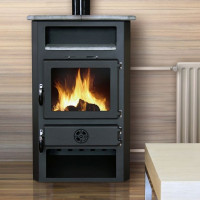 A furnace with a water circuit for heating a house: features of furnace heating + selection of the best option
A furnace with a water circuit for heating a house: features of furnace heating + selection of the best option  How much does it cost to connect gas to a private house: the price of organizing gas supply
How much does it cost to connect gas to a private house: the price of organizing gas supply  The best washing machines with dryer: model rating and customer tips
The best washing machines with dryer: model rating and customer tips  What is the color temperature of light and the nuances of choosing the temperature of the lamps to suit your needs
What is the color temperature of light and the nuances of choosing the temperature of the lamps to suit your needs  Replacement of a geyser in an apartment: replacement paperwork + basic norms and requirements
Replacement of a geyser in an apartment: replacement paperwork + basic norms and requirements
Are there any heat-resistant sealants that can well withstand external weather factors - rain, snow, etc.?
As for sealants for stoves and chimneys, after the polymerization (solidification) process, it is well tolerated by weather factors such as rain and snow. Only you need to apply sealant to the surface of the chimney in suitable conditions:
- no snow and rain;
- ambient temperature not lower than +5 ºС;
- humidity within 50%.
It takes about 1-2 days to harden the sealant, after which it is not afraid of any weather conditions.
From personal experience I can recommend using Penosil sealant, which can withstand temperatures up to +1500 ºС. I personally can confirm the figure of +780 ºС. The sealant can withstand this temperature without any problems; it was not possible to test it above. Rain and snow in no way affect the quality characteristics of this sealant.